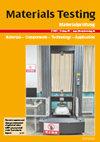Influence of IP-TIG welding parameters on weld bead geometry, tensile properties, and microstructure of Ti6Al4V alloy joints
IF 2.4
4区 材料科学
Q2 MATERIALS SCIENCE, CHARACTERIZATION & TESTING
引用次数: 0
Abstract
The primary aim of this study is to analyze the influence of inter-pulse tungsten inert gas (IP-TIG) welding parameters (peak current, inter-pulse current, and inter-pulse frequency) on weld bead geometry, tensile properties, and microstructure of Ti6Al4V alloy joints for gas turbine applications. IP-TIG welding principally featured by magnetic arc constriction and pulsing was employed to overcome the high heat input problems in TIG welding of thin Ti6Al4V alloy sheets such as wider bead and HAZ, coarsening of beta grains, inferior ductility, distortion of joints, and atmospheric contamination which significantly deteriorates the mechanical performance of welded sheets. The tensile properties and microhardness of IP-TIG joints were evaluated and correlated to the microstructural features. The microstructural features were analyzed using optical microscopy. The fractured surfaces of tensile specimens were studied using scanning electron microscopy. Results showed that the Ti6Al4V alloy joints developed using peak current of 50 A, inter-pulse current of 30 A, and inter-pulse frequency of 20 kHz exhibited greater strength, hardness and elongation. It showed greater tensile strength of 1030 MPa, yield strength of 981 MPa, and elongation of 10 % and FZ microhardness of 391 HV0.2. It is mainly due to the development of refined grains in fusion zone (FZ).IP-TIG 焊接参数对 Ti6Al4V 合金接头焊缝几何形状、拉伸性能和微观结构的影响
本研究的主要目的是分析脉冲间钨极惰性气体(IP-TIG)焊接参数(峰值电流、脉冲间电流和脉冲间频率)对用于燃气轮机的 Ti6Al4V 合金接头的焊缝几何形状、拉伸性能和微观结构的影响。采用以磁弧收缩和脉冲为主要特征的 IP-TIG 焊接克服了 TIG 焊接 Ti6Al4V 合金薄板时的高热输入问题,如焊缝和热影响区变宽、β 晶粒变粗、延展性变差、接头变形和大气污染等,这些问题严重恶化了焊接薄板的机械性能。对 IP-TIG 接头的拉伸性能和显微硬度进行了评估,并将其与微观结构特征联系起来。使用光学显微镜分析了微观结构特征。使用扫描电子显微镜研究了拉伸试样的断裂表面。结果表明,峰值电流为 50 A、脉冲间电流为 30 A、脉冲间频率为 20 kHz 的 Ti6Al4V 合金接头具有更高的强度、硬度和伸长率。拉伸强度为 1030 兆帕,屈服强度为 981 兆帕,伸长率为 10%,FZ 显微硬度为 391 HV0.2。这主要是由于熔合区(FZ)中出现了细化晶粒。
本文章由计算机程序翻译,如有差异,请以英文原文为准。
求助全文
约1分钟内获得全文
求助全文
来源期刊

Materials Testing
工程技术-材料科学:表征与测试
CiteScore
4.20
自引率
36.00%
发文量
165
审稿时长
4-8 weeks
期刊介绍:
Materials Testing is a SCI-listed English language journal dealing with all aspects of material and component testing with a special focus on transfer between laboratory research into industrial application. The journal provides first-hand information on non-destructive, destructive, optical, physical and chemical test procedures. It contains exclusive articles which are peer-reviewed applying respectively high international quality criterions.
 求助内容:
求助内容: 应助结果提醒方式:
应助结果提醒方式:


